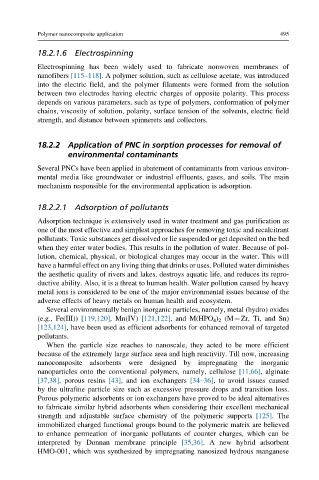Page 542 - Polymer-based Nanocomposites for Energy and Environmental Applications
P. 542
Polymer nanocomposite application 495
18.2.1.6 Electrospinning
Electrospinning has been widely used to fabricate nonwoven membranes of
nanofibers [115–118]. A polymer solution, such as cellulose acetate, was introduced
into the electric field, and the polymer filaments were formed from the solution
between two electrodes having electric charges of opposite polarity. This process
depends on various parameters, such as type of polymers, conformation of polymer
chains, viscosity of solution, polarity, surface tension of the solvents, electric field
strength, and distance between spinnerets and collectors.
18.2.2 Application of PNC in sorption processes for removal of
environmental contaminants
Several PNCs have been applied in abatement of contaminants from various environ-
mental media like groundwater or industrial effluents, gases, and soils. The main
mechanism responsible for the environmental application is adsorption.
18.2.2.1 Adsorption of pollutants
Adsorption technique is extensively used in water treatment and gas purification as
one of the most effective and simplest approaches for removing toxic and recalcitrant
pollutants. Toxic substances get dissolved or lie suspended or get deposited on the bed
when they enter water bodies. This results in the pollution of water. Because of pol-
lution, chemical, physical, or biological changes may occur in the water. This will
have a harmful effect on any living thing that drinks or uses. Polluted water diminishes
the aesthetic quality of rivers and lakes, destroys aquatic life, and reduces its repro-
ductive ability. Also, it is a threat to human health. Water pollution caused by heavy
metal ions is considered to be one of the major environmental issues because of the
adverse effects of heavy metals on human health and ecosystem.
Several environmentally benign inorganic particles, namely, metal (hydro) oxides
(e.g., Fe(III)) [119,120], Mn(IV) [121,122], and M(HPO 4 ) 2 (M¼Zr, Ti, and Sn)
[123,124], have been used as efficient adsorbents for enhanced removal of targeted
pollutants.
When the particle size reaches to nanoscale, they acted to be more efficient
because of the extremely large surface area and high reactivity. Till now, increasing
nanocomposite adsorbents were designed by impregnating the inorganic
nanoparticles onto the conventional polymers, namely, cellulose [11,66], alginate
[37,38], porous resins [43], and ion exchangers [34–36], to avoid issues caused
by the ultrafine particle size such as excessive pressure drops and transition loss.
Porous polymeric adsorbents or ion exchangers have proved to be ideal alternatives
to fabricate similar hybrid adsorbents when considering their excellent mechanical
strength and adjustable surface chemistry of the polymeric supports [125].The
immobilized charged functional groups bound to the polymeric matrix are believed
to enhance permeation of inorganic pollutants of counter charges, which can be
interpreted by Donnan membrane principle [35,36]. A new hybrid adsorbent
HMO-001, which was synthesized by impregnating nanosized hydrous manganese

